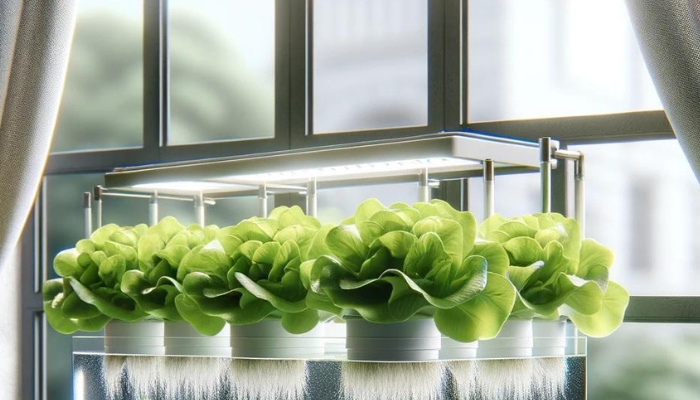The quest for healthy, sustainable, and efficient food production methods has never been more pressing. Enter hydroponics.
Plants grown hydroponically flourish in the absence of soil and thrive under the meticulous care of water-based nutrient solutions.
Lettuce is an ideal plant for a home hydroponic setup. It is easy to grow, requires little care, and is simple to harvest. However, knowing the basics of hydroponic growing is vital.
Choosing Your System
Selecting the right hydroponic system is the first major step in successfully growing lettuce hydroponically as it directly impacts plant growth and yield.
Consider your space, budget, and the level of control you desire over the growing environment.
Among the many options, systems like Deep Water Culture (DWC) and Nutrient Film Technique (NFT) stand out for lettuce cultivation due to their efficiency in water and nutrient delivery.
When choosing your system, don’t overlook lighting considerations. Lettuce requires a balanced light spectrum to photosynthesize efficiently, promoting healthy, rapid growth.
LED grow lights are a popular choice, offering energy efficiency and the ability to tailor the light spectrum to your lettuce’s needs. However, the intensity and duration of light exposure should be carefully managed to avoid stressing the plants.
Climate control is another pivotal factor. Your system should allow for the regulation of temperature and humidity, maintaining conditions that are conducive to lettuce growth while preventing issues like mold and mildew.
An ideal setup would include integrated sensors and automated systems to monitor and adjust these environmental variables, ensuring your lettuce thrives in its hydroponic habitat.
Selecting Lettuce Varieties
Which lettuce varieties best suit your setup for maximum yield and quality? Selection hinges not only on personal preference but also on resistance to common lettuce diseases.
Firstly, assess varieties for resistance to diseases prevalent in hydroponic systems, such as downy mildew, tip burn, and root rot.
Varieties with built-in resistance will significantly reduce your need for chemical interventions, ensuring a healthier crop and potentially reducing your operational costs.
Secondly, consider your personal preferences. Do you prefer romaine, butterhead, loose-leaf varieties, or something else? You don’t have to limit yourself to just one lettuce type. Experiment with a couple of varieties to see what works best.
Setting Up Your System

To establish a successful hydroponic lettuce garden, you’ll need to meticulously set up your system, focusing on the right combination of lighting, nutrient solution, and water circulation.
First, consider your lighting options. Lettuce requires a substantial amount of light, around 14-16 hours per day, for optimal growth.
LED grow lights are an efficient choice. They offer a spectrum tailored for leafy greens while conserving energy. Position your lights evenly above the plants, ensuring all leaves receive equal illumination.
Next, ensure your system’s water is properly balanced. pH testing plays a critical role in hydroponic systems as it affects nutrient availability to your plants.
Lettuce thrives in a slightly acidic environment with a pH range of 5.5 to 6.5. Regularly check the pH levels using a reliable pH meter and adjust accordingly using pH up or down solutions.
This step is fundamental to prevent nutrient lockout and ensure your lettuce has access to the necessary nutrients for growth.
Nutrient and Water Management
A precise nutrient solution and diligent water management are the cornerstones of disease control and optimal growth in hydroponic systems.
Your lettuce will thrive on a balanced nutrient solution tailored for leafy greens. This solution must maintain a pH balance between 5.5 and 6.5 to ensure nutrient availability.
Regular testing and adjustments are essential as imbalances can lead to nutrient deficiencies or toxicities.
Proper water management is equally vital. Recirculating systems require careful monitoring to prevent the spread of pathogens.
Changing the nutrient solution every two to three weeks minimizes disease risks and ensures the consistent provision of fresh nutrients.
Harvesting Your Lettuce
Precise harvesting techniques ensure the highest quality of produce. Begin by examining the plants carefully for any signs of lettuce diseases, which can significantly impact both yield and quality.
Diseases such as downy mildew or botrytis can spread quickly, especially in the humid conditions favored by hydroponic systems. Identifying and addressing these issues promptly can prevent widespread contamination.
When harvesting, use a sharp, clean knife or shears to cut the lettuce at its base. This method minimizes stress on the plant, reducing the risk of disease transmission.
It’s also essential to harvest in the cooler parts of the day, typically early morning or late evening, to prevent wilting and preserve the crispness of the leaves.
After harvesting, immediate attention to storage solutions is paramount. Cool, moist conditions are ideal for lettuce storage. Aim for a temperature range between 32°F and 36°F with a relative humidity of 95-100%.
These conditions help to slow down respiration rates, reduce the loss of moisture and nutrients, and extend the shelf life of lettuce.
Proper post-harvest handling, combined with effective storage solutions, ensures that your hydroponic lettuce remains fresh, crisp, and nutritious until it’s ready to be enjoyed.

